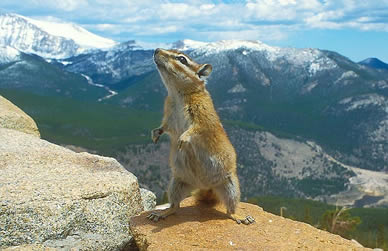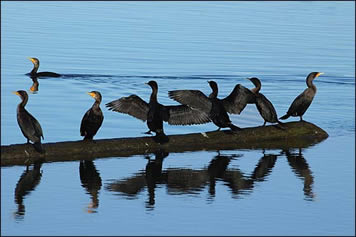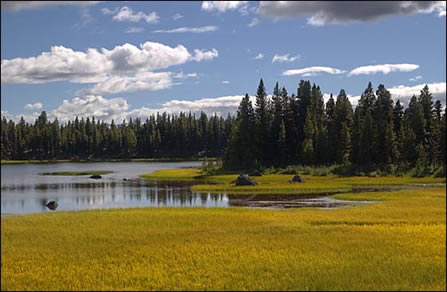

WHAT IS BIODIVERSITY?

Least Chipmunk, Rocky Mountains, photo by David Boag
by
Brian Klinkenberg
Department of Geography, University of British Columbia
Wild thing
You make my heart sing
You make everything groovy
Wild thing
Chip Taylor's song "Wild Thing" might not have been referring to our wild species, but there is no doubt that the wild things of our planet do make everything groovy. They are what this planet is about--the Mountain Gorillas, the Sea Turtles, the wild orchids, the scorpions and spiders, the sea stars, and everything else you can think of. If they are groovy, we are groovy. This is something we need to hold tight to, and should become the mantra of the new green enlightenment that is currently underway. The wild things represent our planet's biodiversity, or, to put it another way, they represent hope for humanity. If we do not sustain our wild things, or biodiversity, then we, as a species, might blink out.
So, what is biodiversity?
Biodiversity has many definitions, but perhaps the best and simplest one is that biodiversity is "all living things on earth". This embraces all species and all genetic variation on earth. There is growing recognition that we need to protect our global biodiversity, and a growing realization that species loss is accelerating. We have moved into a period when the speed of species loss has reached a critical level. We now know, for example, that the amphibians of the world are in a serious state of decline, a decline that seems to be driven by major climate change. We also know that the world's Mountain Gorillas face imminent extinction--a direct result of human warfare. There is trauma in our oceans, with entire "dead zones" that have developed, areas of oxygen depletion. And much, much more.
In protecting biodiversity, we strive towards protection of species and their habitats. Habitat protection is critical if global biodiversity is to persist. Wild species cannot survive without their homes, their food sources, their breeding areas and migration areas and, something we don't think about, migration stopover areas--areas that allow migrating species to rest and feed on their way to winter or summer homes. Our wild species need these components in order to persist and reproduce. That is, in order to maintain populations. They especially need these components in order to persist in the face of adversity or major change, such as we are seeing now with global climate change.
Macoun's Poppy (Papaver lapponicum) is one of nine native and non-native
species of poppy found growing in the wild in BC. Photo by Ian Cumming
Biodiversity in BC
British Columbia is one of the most biologically diverse provinces in Canada, rivaled only by Ontario with its large intrusions of Carolinian species and habitats. BC's biodiversity is tied directly to the impressive array of habitats and ecosystems that are found here, from mountains to wetlands to forests to oceans to river systems. It is also tied to the variation in climate that the province experiences, from cool coastal climates to the dry lands of the Okanagan. This variation leads to the many species groups we find here, from the marine mammals of our coastal waters to the breathtaking displays of alpine flora in our mountain regions. Biodiversity in BC covers everything from bears to bees, wild lettuce and wild roses, to the great kelp beds of the Pacific Coast.
BC's Flora and Fauna
When it comes to the diversity of plants and animals that are found in BC, this province has more species than any other Canadian province. These include native species as well as species that have arrived here from somewhere else. In the plant world, we have species that specialize or grow in alpine areas (on mountain slopes, in mountain ravines), in wetlands (marshes, swamps, fens, bogs and vernal or spring pools), in dry-land areas (sagebrush steppe and pocket desert), and in salt water (the kelp and other seaweeds that inhabit the Pacific Ocean, or species that live in saline lakes and ponds). In the animal world we find caribou herds, colonial nesting birds (such as gulls and herons), wolf packs, wild horses, and even scorpions in the 'pocket desert' around Osoyoos.
In order to learn more about the species that make up the biodiversity of British Columbia, visit the biogeographic atlases of BC: E-Flora BC and E-Fauna BC. While these atlases are still being compiled, we can already see the great numbers of species that this province supports and discover where they live.

Double-crested Cormorants (Phalacrocorax auritus) are one of our species of
colonial-nesting birds. Photo by Gerald and Irmgard Carter.

Wild Carrot or Queen Anne's Lace (Daucus carota), a wild relative
of our cultivated carrot. Photo by Diane Williamson.
Biodiversity in our homes
But let's think of biodiversity in a different way. Lets think about domesticated or cultivated species of plants and animals--species such as horses, donkeys, dogs, cats, or even our food plants such as broccoli, carrots, lettuce, potatoes--all derived originally from wild species. Without the original wild horses or wild carrots, what would we be eating, and where would our civilizations be today? These domesticated species also represent biodiversity.
A good example of the relationship between cultivated plants and wild plants is the carrot. Wild carrot is Daucus carota, while the cultivated carrot is Daucus carota subsp. sativa which arose from the wild species. This major cultivated food probably was originated in the middle east and was bred to reduce the bitterness of the wild plants.
Another good example of how we derived food plants from wild plants and their relationships to the wild plants of the world, is the familiar lettuce. The lettuce we eat is Lactuca sativa, a member of the family Asteraceae (the daisy family) that has been cultivated for many centuries. In BC, we have four species of wild lettuce (Lactuca biennis, L. canadensis, L. ludviciana and L. serriola. You can easily see the relationship between our wild lettuces and our familiar cultivated one when the cultivated one 'bolts' in our garden and flowers. It shows the characteristic 'lettuce' flowers.
There are many examples of wild plants that have become food plants, and no doubt there are many wild plants that could still become food plants, or medicines, which is another reason why is it important to protect our wild species.A toe of the Bear River Glacier near Stewart, BC. Glaciers have played a major role in determining the species composition of a region. Photo by Gerald and Irmgard Carter.
Factors that Influence Biodiversity
Many factors influence biodiversity, from the physical features of the landscape around us that provide living space (niches) for species, to rivers and glaciation and erosion that modify physical features and provide habitat niches. Variation in rainfall and annual precipitation contributes to biodiversity by, resulting in wetter and drier regions. Annual temperatures and number of frost free days determine which species can grow in a region. All of these geographical factors combine to form the conditions that produce a regional flora and fauna.
Maintaining intact populations and ecosystems is important to biodiversity protection. And it is especially important as we face global climate change. Intact ecosystems and intact species populations will have more resilience in the face of change, and will allow for species persistence in the face on increased competition and changing growing conditions. Evidence of climate change is apparent in many areas around the world, including the Arctic and the Antarctic. Can our wild species survive this?
Glaciers in BC provide an opportunity to view climate change in action as they retreat. Click here for more information on glaciers in BC.
We will explore some of the factors that influence biodiversity in the essays presented on this site.
Stewardship and the future
The biodiversity of our planet is important to human survival, but it is also inherently valuable, with or without humans. Wild species make our ecosystems tick, they help keep our drinking water fresh, some create ecosystems (think of the Canadian Beaver, master architect). Ecosystems and plants and animals are so linked that if we remove some of them, we might inadvertently remove all of them through a cascading ecological effect.
As responsible stewards of our planet, we must ensure that the complex array of biological diversity is maintained and not destroyed by expanding human populations. We must ensure that ecosystems remain whole and healthy. If we don't, humans will feel the effects. It is the wild things that offer hope for humanity. The wild things are far more important than we are.

Wetland systems, such as this lake in the Chilcotin, support large arrays of species and also have important hydrological functions. Photo by Gerald and Irmgard Carter.
Please cite these pages as:
Author, Date. Page title. In Klinkenberg, Brian. (Editor) 2020. Biodiversity of British Columbia [www.biodiversity.bc.ca]. Lab for Advanced Spatial Analysis, Department of Geography, University of British Columbia, Vancouver.
All material found on this web site is covered by Canadian Copyright Laws. Please contact the respective copyright holder if you wish to use any illustration, photograph or text.